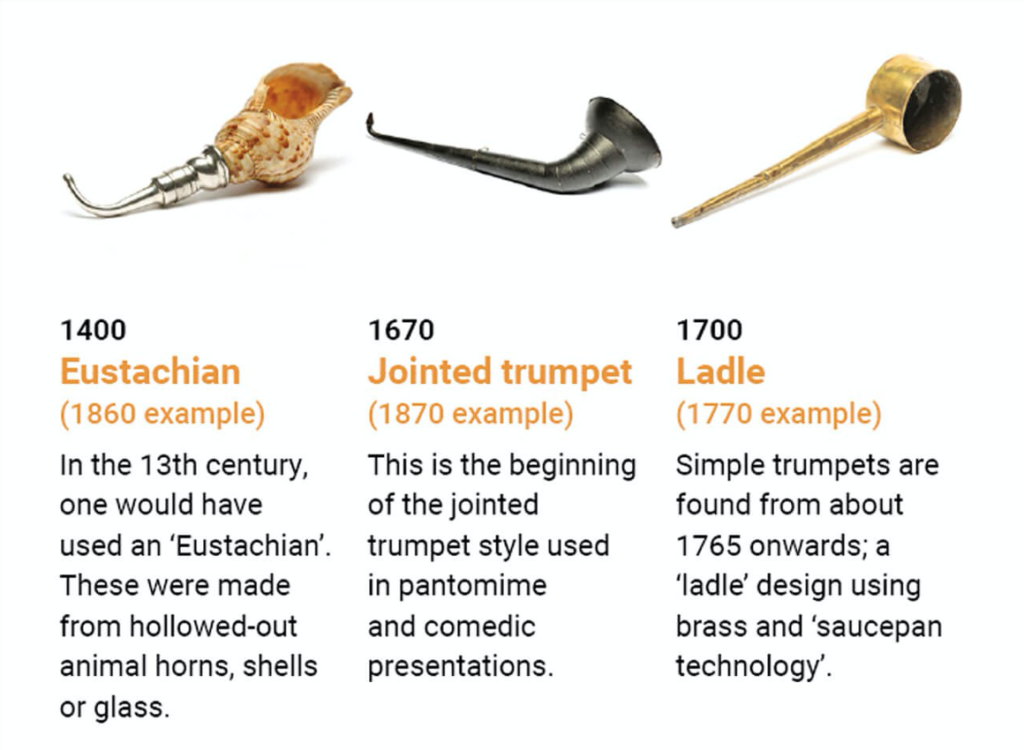A Brief History of the Acoustic Ear Trumpet and Some Collection Favourites
Reprinted with permission from Audiology and ENT News (2023).
If you think you know a thing or two about ear trumpets, I’d bet Michael Briggs knows more! In this fascinating article, he tells the history of the ear trumpet, as well as sharing some wonderful pictures from his Guiness World Record collection.
In the year 2001, my impaired hearing was following the trend set by my mother and two grandparents, and had become an issue. For a significant birthday, my family clubbed together to purchase a nearly 200-year-old solid silver ear trumpet in the forlorn hope it would be a life asset - it wasn’t. The trumpet proved to be virtually useless. Simple physics suggested that the wide end of the trumpet needed to be much larger than the human ear to collect more sound.
I researched antique ear trumpets and soon discovered that, in addition to a simple tapered horn, one could buy antiques in the form of a double parabola London Dome or Banjo, or even a metre-long conversation tube. Samples were quickly acquired, and the world-class Packington Collection was started. My collection is predicated on the realisation that a huge variety existed in the historical implementation of ear trumpets. The illustrations in this article are taken from items in the collection.
The earliest-found reference to an ear trumpet is the example found in King Tutankhamun’s tomb – 1332 BC. This is a solid silver small horn, visually very similar to the auricle shape (see picture 1815). Although not strictly an ear trumpet, pipes and tubes were also used in buildings to transmit sound. A 400 BC illustration shows a pipe for conveying the sound laid between the dungeons at the foot of the mountain made by Dionysos in Sicily and the guard room at the summit. Similar building constructions were used through to Victorian times, mainly to eavesdrop. In Victorian mansions long tubes were used to communicate between the gentry in living rooms and the servants.
Even the Romans tackled the issue. Contemporary court descriptions tell of Emperor Hadrian b. 76 AD cupping his hand behind his ear in order to hear better. He is also recorded as wearing small parchment cups behind his ears and having his throne in a concave alcove to reflect sound. It is much later that we find small instruments reminiscent of Victorian ear trumpets.
In a 1558 book called Natural Magick, an Italian doctor, scientist and cryptographer, Giovanni Battista Porta, described wooden ear-shaped cups to fit over the ears. Over the next 250 years, a variety of designs and iterations of the ear trumpet are documented in history, including an engraving in the Wellcome Foundation collection dated 1780, which shows a chair designed for use by the deaf incorporating a hearing device. By the 1800s, quite a wide variety of ear trumpets were being mass produced for sale. These came in all sorts of shapes and sizes. Most of the smaller items were fairly useless, but served to indicate one needed to shout at the holder.
Mass production of the ear trumpet surged then dwindled in the early 20th century, but a few makes held on until the 50s. In 1948, the UK National Health Service (Medresco) introduces a range of at least six different ear trumpets designs, most of which are datemarked. Eschmann tapered conversation tubes were made in the UK right up to 1976, although the design was virtually unchanged from the early commercially produced examples in the 1880s.
The NHS took delivery of 20,000 units in 1976. I was in my mid-thirties in ‘76 and never saw a person in public with a trumpet, but plenty of pink plastic thermionic valve-based units.
The rows of illustrations show collection items in date order; these emphasise the variety found. The last row shows six NHS ear trumpets.






NHS-issued trumpets


Some favourites in my World Record collection:
The three rows of pictures show my favourites in size order, further emphasising the variety found. No two images are really alike.(The captions indicate date, length in mm, location found, reason for being a favourite, sorted by length ascending.)






Note: Object dating is a nightmare, but many of these objects are shown in one or more of the 70 maker’s catalogues kept in the collection, which has been very helpful.
All of these images are of items in the Packington Collection, 563 all-different ear trumpets on permanent public display in one room at the Oswestry Town Museum, Oswestry SY11 1PZ, UK. https://oswestrytownmuseum.co.uk

